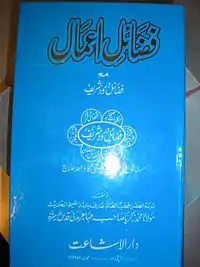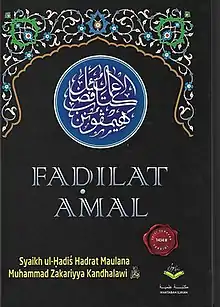Fazail-e-Amaal
Faza'il-e-A'maal (Urdu: فضائل اعمال, Faz̤ā’il-i a‘māl [Virtues of deeds]), originally titled Tablighi Nisab (Urdu: تبلیغی نصاب, Tablīg͟hī niṣāb [Curriculum for Tabligh]), is a religious text composed mainly of treatises by the Indian Deobandi hadith scholar Muhammad Zakariya Kandhlawi for Tablighi Jamaat.[3] The book is written in simple and lucid Urdu and is a collection of pious and edifying tales, based mostly on inspirational hadith traditions and anecdotes.[4][5][6] Tablighi Jamaat promote the book to the non-Arab communities, while to Arabic speaking communities they suggest reading Riyad as-Salihin by Yahya Nawawi instead.[7][8]
 An Urdu edition of Faza'il-e-A'maal | |
| Author | Muhammad Zakariya Kandhlawi |
|---|---|
| Language | Urdu, Arabic, French, and Malay |
| Genre | Islam, Hadith, Sufism |
Publication date | between 1928 to 1940[1] or 1955[2] |
Published in English | 1984 (South Africa) |



The book has been translated into several languages, including: Arabic, French, and Malay.
History
In the preface of the book is mentioned that, Muhammad Zakariyya Kandhlawi wrote, "Hikayat-e-Sahaba" at the request of Abdul Qadir Raipuri, "Fazail-e-Quran" (Virtues of Quran) at the request of Muhammad Yasin Niginwi, "Fazail-e-Namaz", "Fazail-e-Zikr", "Fazail-e-Tableegh" and "Fazail-e-Ramadan" at the request of his uncle Muhammad Ilyas Kandhlawi. "Fazail-e-Sadaqat" and "Fazail-e-Hajj" was written at the request of Muhammad Yusuf Kandhlawi.[9]
In about 1955 a collection of works by Muhammad Zakariya was published in two volumes under the title Tablighi Nisab.[10] A single volume version was published in 1958.[10] The first English translation was published in 1960.[10] A revised English edition was published by Kutub Khana Faydi in Lahore in 1980.[10] Another English translation of the book was published in 1984 by Waterval Islamic Institute, Johansberg and later become immensely popular in South Africa.[11] In 1985, the translations from the second edition were published in Delhi as Teachings of Islam.[10] The English edition published in Delhi in 1986 contained both parts one and two; part two was omitted from later versions.[10] Kutub Khana Faydi published the third revised English edition of the book in 1985 as Faza`il A`maal.[10] The 1987 Karachi edition was a reprint of the third edition, and was reprinted in England and South Africa.[10] A simple English edition was published in 1995.[10] The 1985 Kutub Khana Faydi edition has been published in French translation.[10] The English and French translations retain the madrasa idioms, and the Uttar Pradesh town background and world-view of the original Urdu books.[10] A Turkish version has also been published titled Ammelerin Faziletleri.
Overview
Some new Urdu editions also add:
- Muslim Degeneration and its Only Remedy (1939) (Urdu: مسلمانوں کی موجودہ پستی کا واحد علاج, Musalmānoṉ kī maujūdah pastī kā wāḥid ‘ilāj) by Ihtishamul Hasan Kandhlawi.[12]
English editions include writings such as:
- Six Fundamentals (translation of Ashiq Ilahi Bulandshahri's Chhe Baten (Urdu: چھ باتیں, Chha bāteṉ [Six points])),[13]
- A Call to Muslims (translation of a 1944 speech by Muhammad Ilyas Kandhlawi),[13] and
- Muslim Degeneration and its Only Remedy (1939) (translation of Ihtishamul Hasan Kandhlawi's Musalmānoṉ kī maujūdah pastī kā wāḥid ‘ilāj).[13]
Some editions of Faza'il-e-A'mal do not contain:
Contents
The book has two parts (or volumes):[14]
- Part one
- Stories of sahabah (Ḥikāyāt-i Ṣaḥābah). This consists of stories of Mohammad's companions, depicting them as role models for Muslims. (272 pages)[10]
- Virtues of the holy qur'aan (Faḍā’il-i Qur’ān). Forty hadith on the merits of the Quran. (120 pages)[10]
- Virtues of salaat (Faḍā’il-i Namāz). Hadith on the merits of prayer. (112 pages)[10]
- Virtues of zikr (Faḍā’il-i Dhikr). Quranic verses and hadith on the merits of phrases known as kalima that are used to remember God. (265 pages)[10]
- Virtues of tabligh (Faḍā’il-i Tabligh). The significance of preaching the faith. (48 pages)[10]
- Virtues of ramadan (Faḍā’il-i Ramaḍān). The merits and significance of ramadan, the month of fasting. (80 pages)[10]
- Muslim Degeneration and its Only Remedy (Musalmānoṉ kī maujūdah pastī kā wāḥid ‘ilāj). The history and causes of Muslim degeneration and how preaching the faith will solve this problem. (48 pages)[10]
- Six Fundamentals (Chhe bāteṉ}
- Virtues of durood (Faz̤ā’il-i durūd sharīf)
- Part two
- Virtues of charity (Fazail-e-Sadqaat)
- Virtues of hajj (Fazail-e-Hajj)
Fazail-e-Sadqaat
The Fazail-e-Sadqaat (Urdu: فضائلِ ﺻﺪﻗﺎﺕ) is the second volume of the Fazail-e-Amaal series, a compilation of selected chapters from various books, also written by Muhammad Zakariya Kandhlawi.[15][16][17]
The text consists of selected verses of the Qur'an, Hadiths, commentary thereon, and other material. The book is a compilation of different previous books written by same author. It has been translated into English, Arabic, Persian, Bengali, and many other languages. Initially it was popular in Pakistan, India, Bangladesh and among South Asian immigrants in the United States or UK but now the popularity is exponentially grown up in recent years all over the Europe, Asia Pacific, African and Latin American countries. It is also used by the Tablighi Jamaat for taalim (teaching) purposes.
Criticism
The book has been claimed to be based mostly on historically suspect and non-authentic hadith traditions and anecdotes.[4][5][6] The Ahl al-Hadith and Salafi communities allege that this Islamic book contains references to many baseless hadiths. So they continue to preach not to read the book. The Salafi scholar Salih Al-Munajjid said, "the scholars continue to warn against the book Tableeghi Nisaab, otherwise known as Fadaa’il al-A‘maal. It is not permissible for any Muslim to read it; rather they should focus on the books of the saheeh Sunnah, books whose authors follow the path of Ahl as-Sunnah wa’l-Jamaa‘ah. As for books that contain myths and lies, they should not have any place in the heart or mind of the Muslim."[18]
Hammood at-Tuwaijri wrote that the Tabligh Jamaat "pay a great deal of attention to this book, which they respect as Ahl as-Sunnah respect as-Saheehayn and other books of hadeeth. The Tableeghis have made this book the most important reference work for the Indians and other non-Arabs who follow them. It contains a great deal of matters of shirk, innovation (bid'ah), myths, and fabricated (mawdoo‘) and weak (da‘eef) hadeeths. In fact it is a book of evil, misguidance and confusion (fitnah)."[19]
Shams ad-Deen al-Afghaani wrote, "The leading imams of the Deobandis have books which are venerated by the Deobandis, but they are filled with the myths of grave-worshippers and Sufi idolatry, such as – and he mentioned a number of books, including Tableeghi Nisaab, i.e., Nisaab at-Tableegh, and Manhaj at-Tableegh. These Deobandis did not openly disavow these books or warn against them, and they did not put a stop to the printing and sale of these books. The markets of India and Pakistan and elsewhere are full of them."[20]
It is said in Al-Mawsoo‘ah al-Muyassarah fi’l-Adyaan wa’l-Madhaahib wa’l-Ahzaab al-Mu‘aasirah, "In their gatherings in Arab countries they – i.e., Jamaa‘at at-Tableegh – focus on reading from Riyadh as-Saaliheen, but in non-Arab countries they focus on reading from Hayat as-Sahaabah and Tableeghi Nisaab; the latter book is full of myths and da‘eef (weak) hadeeths."[21]
References
- Malik, Jamal (2020). Islam in South Asia: Revised, Enlarged and Updated Second Edition. BRILL. p. 488. ISBN 978-90-04-42271-1. Retrieved 12 August 2020.
- Younis B I Al-Turkistany (2011). "A critical Hadith study of the Tablighi Nisab and its intellectual impact on the Jama at Al-Tabligh". etheses.bham.ac.uk. University of Birmingham. Retrieved 11 August 2020.
- Gabriele Marranci (17 December 2013). Studying Islam in Practice. Routledge. pp. 214–. ISBN 978-1-317-91424-2.
- Sciences, American Academy of Arts and (1994). Fundamentalisms Observed. University of Chicago Press. p. 516. ISBN 978-0-226-50878-8. Retrieved 19 July 2020.
- Salam, Ziya Us (2018). Of Saffron Flags and Skullcaps: Hindutva, Muslim Identity and the Idea of India. SAGE Publishing India. ISBN 978-93-5280-736-9. Retrieved 19 July 2020.
- Islam, Md. Saidul; Islam, Md. Nazrul (2020). Islam and Democracy in South Asia: The Case of Bangladesh. Springer Nature. p. 197. ISBN 978-3-030-42909-6.
- Bowering, Gerhard; Crone, Patricia; Kadi, Wadad; Stewart, Devin J.; Zaman, Muhammad Qasim; Mirza, Mahan (2012). The Princeton Encyclopedia of Islamic Political Thought. Princeton University Press. p. 539. ISBN 978-1-4008-3855-4. Retrieved 19 July 2020.
- Jaleel, Talib (2015). Notes On Entering Deen Completely: Islam as its followers know it. EDC Foundation. p. 1022. Retrieved 19 July 2020.
- Muhammad Zakariyyah Kandhlawi. "Preface". Fazail e Aamal (in Urdu). 1 (2009 ed.). New Delhi: Samee Publicatons. p. 5.
- Masud, Muhammad Khalid (2000). Travellers in Faith: Studies of the Tablīghī Jamāʻat as a Transnational Islamic Movement for Faith Renewal. BRILL. pp. 82–85. ISBN 978-90-04-11622-1. Retrieved 21 August 2020.
Statements regarding the number of pages in various parts of Fazail-e-Amaal refer to the 1987 Karachi edition. - Ingram, Brannon D. (2018). Revival from Below: The Deoband Movement and Global Islam. Univ of California Press. p. 260. ISBN 978-0-520-29800-2. Retrieved 13 August 2020.
- Masud, Muhammad Khalid (2000). "Ideology and Legitimacy". In Masud, Muhammad Khalid (ed.). Travellers in Faith: Studies of the Tablīghī Jamāʻat as a Transnationa sufi Movement for Faith Renewal. Brill. ISBN 9004116222.
- Metcalf, Barbara D. (Aug 1993). "Living Hadith in the Tablighi Jama'at". The Journal of Asian Studies. Association for Asian Studies. 52 (3): 584–608. doi:10.2307/2058855. ISSN 0021-9118. JSTOR 2058855.
- "Index", Fazail-e-Amaal (fazaileamaal.com), retrieved 21 August 2020
- Noor, Farish A. (2012). Islam on the Move: The Tablighi Jama'at in Southeast Asia. Amsterdam University Press. ISBN 978-90-8964-439-8. Retrieved 22 August 2020.
- Schroeter, Susanne (2013). Gender and Islam in Southeast Asia: Women's Rights Movements, Religious Resurgence and Local Traditions. BRILL. p. 271. ISBN 978-90-04-24292-0. Retrieved 22 August 2020.
- Jaleel, Talib (2015). Notes On Entering Deen Completely: Islam as its followers know it. EDC Foundation. p. 1022. Retrieved 22 August 2020.
- Al-Munajjid, Muhammad Salih (17 July 2013). "Critique of the book Fadaa'il al-A'maal". Islam Question & Answer, islamqa.info. Retrieved 21 August 2020.
- at-Tuwaijri, Hammood. al-Qawl al-Baleegh. p. 11.
Quoted in al-Kandahlawi, Muhammad Zakariyya (17 July 2013). Al-Munajjid, Muhammad Salih (ed.). "Critique of the book Fadaa'il al-A'maal". Islam Question & Answer, islamqa.info. Retrieved 21 August 2020. - al-Afghaani, Shams ad-Deen. Juhood 'Ulama' al-Hanafiyyah fi Ibtaal 'Aqaa'id al-Qubooriyya. 2. p. 776.
Quoted in Al-Munajjid, Muhammad Salih, ed. (17 July 2013). "Critique of the book Fadaa'il al-A'maal". Islam Question & Answer, islamqa.info. Retrieved 21 August 2020. - Al-Mawsoo'ah al-Muyassarah fi'l-Adyaan wa'l-Madhaahib wa'l-Ahzaab al-Mu'aasirah. 1. p. 322.
Quoted in Al-Munajjid, Muhammad Salih, ed. (17 July 2013). "Critique of the book Fadaa'il al-A'maal". Islam Question & Answer, islamqa.info. Retrieved 21 August 2020.

